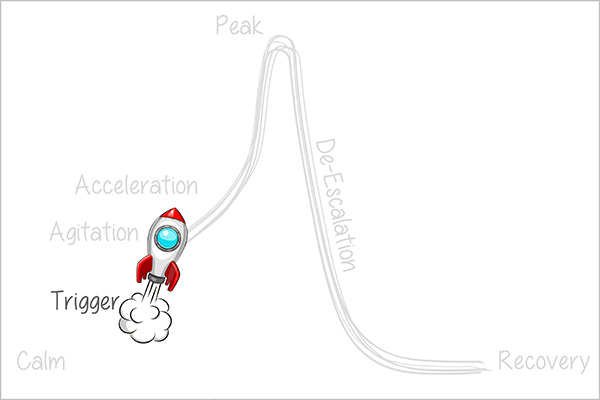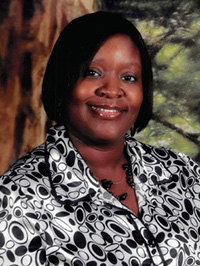How can educators recognize and intervene when student behavior is escalating?
Page 4: Trigger
 If calm behavior is not maintained, some students may move out of the Calm Phase and into Phase 2—the Trigger Phase. This phase can happen suddenly and seemingly without warning. Students are often triggered or “set off” by an issue or concern either left unaddressed or inadequately resolved. Triggers can take place within the school environment, outside of school, or a combination of both. As such, a teacher may not have observed a trigger that occurred within a previous classroom, in the hallway, lunchroom, bathroom, or at home. See the table below for some common school-based and non-school-based triggers.
If calm behavior is not maintained, some students may move out of the Calm Phase and into Phase 2—the Trigger Phase. This phase can happen suddenly and seemingly without warning. Students are often triggered or “set off” by an issue or concern either left unaddressed or inadequately resolved. Triggers can take place within the school environment, outside of school, or a combination of both. As such, a teacher may not have observed a trigger that occurred within a previous classroom, in the hallway, lunchroom, bathroom, or at home. See the table below for some common school-based and non-school-based triggers.
| School-Based Triggers | Non-School-Based Triggers |
|
|
What a Student Looks Like
In the Trigger Phase, some unmet need creates an unresolved problem for the student. This can trigger a behavior that may go unnoticed by the teacher. In this phase, a student may appear:
- Restless
- Frustrated
- Anxious
In this video, note the behaviors that Nora displays during the Trigger Phase (time: 1:21).
Transcript: Trigger Phase
Teacher: Three times zero equals zero. Next, we need to multiply …
[Nora sighs heavily in frustration, rolls her eyes, and crosses her arms.]
Teacher: … three times the digit in the tens place which is four. What do we do next?
[Nora sighs heavily in frustration and makes a noise with her mouth.]
Jordan: Multiply three times four, which is 12.
Teacher: Nice, three times four is 12, and there we go.
[ Johanna Staubitz commentary ]
Now, instruction has continued, and peers are continuing to work through questions with Mr. Santini, and we do see signs that it’s starting to take its toll on Nora and her feelings and her behavior here so she’s kind of starting to make a little noise, look away from the instruction and the peer who’s talking with the teacher, rolling her eyes. And these are all signals that an escalation is beginning. And it’s pretty important here that Mr. Santini notice and intervene before the escalation continues. And if he were to do so he should do so, or the way he could intervene that’s most likely to have an effect is one that allows Nora to move on so that she doesn’t have to wait while her peers ask these silly questions.
Strategies To Implement
Fortunately, teachers can use strategies to prevent behavior from escalating into more serious phases of the acting-out cycle. These strategies can help teachers to anticipate and effectively respond to a student’s trigger(s). When teachers work to prevent or properly address triggers, it is more likely that a student’s challenging behavior will de-escalate, causing them to return to the Calm Phase. However, if a student’s concerns are not properly addressed, it is almost certain that the behavior will escalate, moving to the next phase in the acting-out cycle. The table below includes steps to take, as well as tips teachers can use to address triggers.
| Steps | Tips |
|
|
|
x
Precorrection Behavior strategy that entails reminding a student of appropriate behavior before the student can make an error; can be given either to groups of students or to an individual student.
|
|
|
If strategies used in this phase are successful, the student will return to the Calm Phase. In this video, Mr. Santini intervenes effectively to interrupt the acting-out cycle at the Trigger Phase and helps Nora return to the Calm Phase (time: 1:15)
Transcript: Trigger Phase with De-escalation Strategy
Teacher: Three times zero equals zero. Next, we need to multiply …
[Nora sighs heavily in frustration, rolls her eyes, and crosses her arms.]
Teacher: …three times the digit in the tens place which is four. What do we do next?
[Nora sighs heavily in frustration and makes a noise with her mouth.]
Jordan: Multiply three times four, which is 12.
Teacher: Nice, three times four is 12, and there we go.
Teacher: [To Nora] Hey, it looks like you might be ready to move on. Do you want to pick one of these to work on while I finish with the group? Awesome! Thank you.
[ Johanna Staubitz commentary ]
Now, in this alternate universe, Mr. Santini is aware of Nora’s trigger and has noticed that she’s showing signs of frustration, he’s noticing her restlessness and her noises and that she’s starting to orient away from the work, and he approaches her privately, somewhat privately. He is teaching in the front of the classroom, and he’s got his stack of work in his hand because that is what’s coming next for the whole class. And he goes ahead and offers her a couple of options to move on while he finishes the homework review. And again, this comes back to knowing the student and having a relationship with the student, because he knows that Nora is able to do the work without the review that the rest of the class seems to need.
In this interview, Kathleen Lane discusses how to anticipate and manage known triggers to interrupt the acting-out cycle. Next, Janel Brown explains how teachers can prevent triggers from occurring.

Kathleen Lane, PhD, BCBA-D
Professor, Department of Special Education
Associate Vice Chancellor for Research
University of Kansas
(time: 2:38)
Transcript: Kathleen Lane, PhD, BCBA-D
As we think about triggers, when you have students who appear to be struggling regularly, you might consider connecting with them and perhaps a family member to see how you can best support that student. When it is not possible to work with the student or their family, you might just walk through these steps yourself. There are many non-school-based things that you can’t manage. For example, I may not be able to solve major problems such as financial distress for families, but if I know that a student has not had breakfast, I can make arrangements for the school cafeteria folks to have an extra breakfast available for them. And in this way, that student can come in, eat first thing, so that they can be fed and ready to learn. Similarly, if you have a student that’s constantly truant or tardy, then you can meet with that student and say, “You know, these last three days I’ve noticed you’ve been late every day. Can you tell me a little bit about what’s going on? Is there anything I can do to help you to get to school on time?” And it could be that they’d say something along the lines of, “Well, I don’t have an alarm clock at my house, and nobody will wake me up. And so I get up and I still have to make my lunch and find my clothes and that kind of thing.” So you might think about saying to them something along the lines of, “How can we better handle the night before? What about if you packed your lunch the night before, so that’s ready to go? How would you feel about maybe even laying out your school clothes the night before? So you have everything you need, like your shoes, your socks, and all that kind of stuff.” And thinking through this in a problem-solving fashion, you can help them on the front side so they don’t run into those problems that they’re confronted with first thing in the morning when they wake up. And for students that don’t respond well to schedule changes, there can be another strategy called pre-correcting that happens beforehand. So even when it’s exciting things and sometimes when it’s not exciting things [laughs], you can still use that pre-correction strategy and it could look like this: “Now, remember, this week we’re having an assembly, and while we’re all going to be super excited about being there, it’s super tempting to get loud when we’re excited, but we still have to make sure that we’re keeping things cool and under control.” If you’re at the elementary level, that might look like giving them language to remind them to use their inside voices.
When we think about clarifying the parameters of what you expect before that day gets there, if you’re going on a field trip, we just want to make sure that you have clarified the parameters so that you can keep them safe and really help them to have an enjoyable time wherever you are. If it’s an apple orchard field trip, we certainly don’t want them running out of control because we haven’t thought to tell them what to expect on the day. So the goal here is to anticipate and manage known triggers so that we can interrupt the acting-out cycle before things really get started.
Transcript: Janel Brown
You can identify triggers once you get to know your kids and you build that relationship. Most of the time it’s because of an assignment that they just don’t understand. They’re not going to raise their hand and say, “This is hard. I can’t do this.” They will sit there and struggle through it or get upset. They don’t want their classmates to think, “Oh, you know, she’s dumb.” But once you build that relationship with your students, you get to know them, you know when something triggering is going on. So, you just have to be very vigilant in watching your students and the body language, the slump in the chair, head back, heads down, they’re doodling with stuff inside the desk. It’s avoidance. They’re trying to avoid whatever it is that you’ve given them to do.
As a gen ed teacher, what you can do ahead of time is if you know that this hard assignment is going to be a trigger for Johnny, maybe you’re just going to put one of those hard math problems on a sheet instead of Johnny seeing the sheet with ten problems. You can have a cheat sheet posted in front of your classroom. These are the steps to solve this type of problem so that when Johnny is working, he can look up, he can see those steps posted for him. Maybe there is a cheat sheet that he can keep on his desk in his folder that he can use to help him figure out these problems. You try to do anything to lessen the trigger factor. You just try to find what works for that student, and you plan for it ahead of time. It’s all about getting to know Johnny and know what his triggers are. What can I do ahead of time to help lessen that trigger for Johnny?
Activity
As you review Kai’s behavior in this video, think back to what you learned about him in the Challenge.
Transcript: Trigger Video
Teacher: Okay, so today we are going to do a popcorn activity with fun facts you learned about Tennessee and if you want, you can read them right from your book.
Teacher: Okay, let’s see. Diamond, could you start us off?
Diamond: Sure. Tennessee touches eight other states: Missouri, Kentucky, Virginia, North Caro-N-North Carolina, Arkansas, Georgia, Mississippi, and Alabama. Popcorn, Haley.
Haley: Tennessee is tied with Missouri for the state with the most borders. Popcorn, Riley.
From the options below, select the most likely trigger for Kai’s behavior.
- What are some signs that Kai is in the Trigger Phase?
- Explain how Mr. Santini could have prevented Kai’s trigger and interrupted the acting-out cycle. Provide an example in your response.
Now that you’ve had a chance to reflect, listen to Johanna Staubitz’s feedback (time: 1:30).

Johanna Staubitz, PhD, BCBA-D
Associate Professor
Department of Special Education
Vanderbilt University
Transcript: Johanna Staubitz
So, there are many things that Mr. Santini could have done to intervene at this Trigger Stage, or to address Kai’s trigger behavior and help him hop off of that escalation cycle. And one of those things is simply giving a precorrection to the entire class, reminding them that if they run into a challenge they can ask for help. Also reminding them of what the assignment requires. So, Mr. Santini said when he introduced this assignment that students could just share a fact about Tennessee, or they could read it directly from their text. So reading isn’t actually required here and if reading is part of the trigger for Kai, especially in front of his peers, it might be really important for Mr. Santini to make it extra clear that it’s not actually necessary.
Now it’s also just challenging for a student to produce a fact without reading, so that may not be sufficient. An alternative way Mr. Santini could deal with Kai’s trigger is that once he notices the signs that Kai is disengaged and potentially beginning escalation due to this popcorn reading activity, the threat that Kai will be called on, would be to just (as another student reads) kind of crouch down at Kai’s desk subtly and say, “Hey, you know if you get caught and you’re not ready you can just popcorn someone else right away or ask for help.” So maybe deliver a more specific precorrection to Kai individually, if you miss the opportunity to do so with the whole class.
